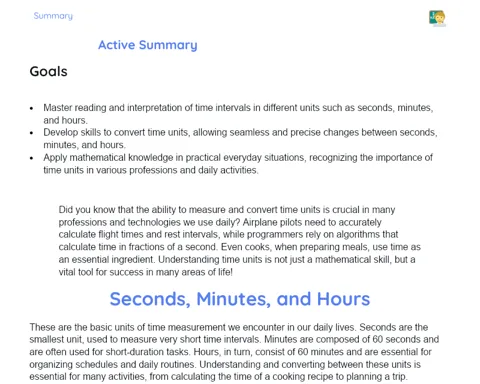Introduction
Relevance of the Topic
The ability to make predictions and decisions based on probabilities is a critical skill in both mathematics and daily life. Probability provides a way to quantify and understand uncertainty. Through the study of probabilities, we can learn to better understand and deal with variability, a concept intrinsic in many aspects of our complex world.
Contextualization
"Predictions with Probability" is situated within the vast field of probability in mathematics. The discipline of mathematics is based on a solid understanding of numerical concepts, operations, and relationships. Probability is a natural extension of these studies, allowing us to examine uncertain events and calculate the likelihood of them happening. This topic is a critical precursor to the study and understanding of more advanced topics such as statistics, game theory, and artificial intelligence, all of which significantly rely on understanding probabilities.
Theoretical Development
Components
-
Sample Space (S): It is the set of all possible outcomes of a random experiment. For example, when rolling a die, the sample space is {1, 2, 3, 4, 5, 6}. In the context of predictions, we are interested in a small part of the sample space, the so-called "event" that is the focus of our prediction.
-
Event (E): It is a subset of the sample space, that is, any collection of possible outcomes of a random experiment. If, for example, we are interested in predicting that a coin will land heads, then this is our event, and the sample space consists of two possibilities: heads (H) and tails (T).
-
Probability (P): It is a numerical measure of the chance of an event occurring. Probability is expressed as a number between 0 (impossible) and 1 (certainty). If the event is impossible, the probability is 0. If the event is certain, the probability is 1.
-
Empirical Method of Probability: This method calculates the probability of an event occurring by the ratio of the number of times the event occurred in an experiment to the total number of experiments. The more experiments we perform, the closer the empirical probability will be to the real probability.
Key Terms
-
Conditional Probability: The probability of an event (event B) occurring, given that another event (event A) has already occurred. This concept is often expressed as P(B | A), and is central to prediction based on contextual information.
-
Compound Event: It is an event that occurs when two or more simple events occur together.
-
Multiplication Rule: This principle states that the probability of two independent events occurring together is the product of their individual probabilities.
Examples and Cases
-
Coin Toss: A classic example in probability theory. If we toss a fair coin, the probability of landing heads is equal to H (heads) / (Heads + Tails) = 1/2 = 0.5. Therefore, if we make a series of predictions based on this, we would expect about half of our predictions to be correct.
-
Six-Sided Die: Another common example is rolling a six-sided die. Each face has the same probability of appearing, so the probability of any number from 1 to 6 appearing is equal to 1/6. Using the multiplication rule, the probability of rolling a 3 followed by a 5 is (1/6) * (1/6) = 1/36, or approximately 0.027. Therefore, if we were to make a prediction about the outcome of two rolls, the number 15 would be expected approximately once in every 36 predictions.
Detailed Summary
Key Points
-
Understanding Probability Theory: Probability theory provides a mathematical framework for dealing with uncertainty. Understanding the concepts of event, sample space, and probability is essential for making accurate predictions.
-
Equally Likely Outcomes: In fair experiments, where all possible outcomes are equally likely, the probability of an event occurring is the ratio of the number of ways the event can occur to the total number of possible outcomes. This is illustrated in the example of flipping a coin, where the probability of heads is 1/2, because there are two equally likely possible outcomes: heads or tails.
-
Conditional Probability: This is a key concept when it comes to making informed predictions. The idea is that if we have additional information, it can affect the probability of an event occurring. For example, if we already know that an even number appeared in a die roll, the probability of rolling a prime number on the next roll is affected by that information.
-
Empirical Method of Probability: Sometimes we do not have access to a theoretical model to calculate probability. In these cases, we can use the empirical method, by conducting a series of experiments and calculating the ratio of successful events to the total number of experiments.
Conclusions
-
Probabilities are not Certainties: A probability-based prediction is never a guarantee that the event will occur. It is just an indication of how likely the event is to occur in an idealized scenario.
-
Informed Predictions: Conditional probability allows for better predictions when we have contextual information. By taking into account what we already know, we can adjust the probabilities of future events.
-
Practice Makes Perfect: The ability to make probability-based predictions improves with practice. By conducting many experiments and reviewing the results, we can refine our prediction skills.
Exercises
-
Dice Game: If you roll a die (with numbered faces from 1 to 6) twice, what is the probability of getting a 3 followed by a 5? Use the multiplication principle.
-
Coin Tosses: If you toss a fair coin three times, what is the probability that all three tosses result in heads? Use the fair probability theory.
-
Empirical Method of Probability: Toss a coin 50 times and record how many times it lands heads. What is the empirical probability of landing heads? Compare it with the theoretical probability.



